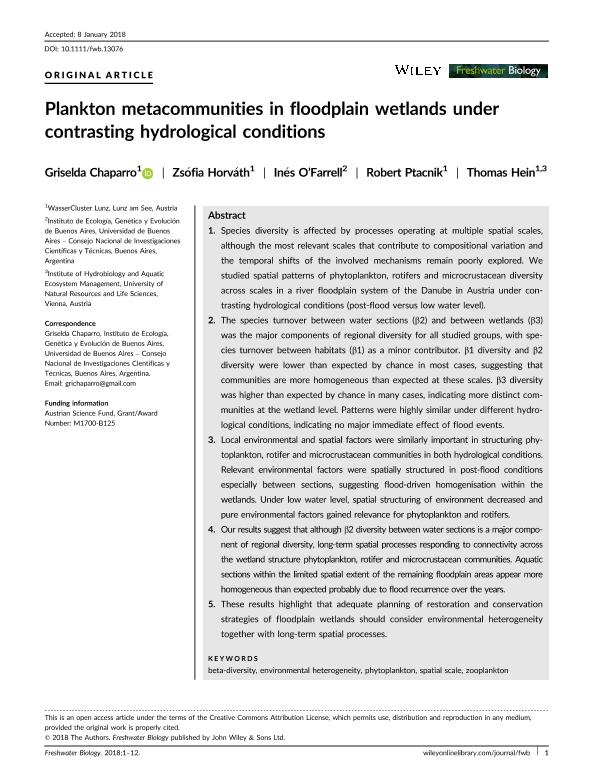Artículo
Plankton metacommunities in floodplain wetlands under contrasting hydrological conditions
Fecha de publicación:
04/2018
Editorial:
Wiley Blackwell Publishing, Inc
Revista:
Freshwater Biology (print)
ISSN:
0046-5070
Idioma:
Inglés
Tipo de recurso:
Artículo publicado
Clasificación temática:
Resumen
Species diversity is affected by processes operating at multiple spatial scales, although the most relevant scales that contribute to compositional variation and the temporal shifts of the involved mechanisms remain poorly explored. We studied spatial patterns of phytoplankton, rotifers and microcrustacean diversity across scales in a river floodplain system of the Danube in Austria under contrasting hydrological conditions (post-flood versus low water level). The species turnover between water sections (β2) and between wetlands (β3) was the major components of regional diversity for all studied groups, with species turnover between habitats (β1) as a minor contributor. β1 diversity and β2 diversity were lower than expected by chance in most cases, suggesting that communities are more homogeneous than expected at these scales. β3 diversity was higher than expected by chance in many cases, indicating more distinct communities at the wetland level. Patterns were highly similar under different hydrological conditions, indicating no major immediate effect of flood events. Local environmental and spatial factors were similarly important in structuring phytoplankton, rotifer and microcrustacean communities in both hydrological conditions. Relevant environmental factors were spatially structured in post-flood conditions especially between sections, suggesting flood-driven homogenisation within the wetlands. Under low water level, spatial structuring of environment decreased and pure environmental factors gained relevance for phytoplankton and rotifers. Our results suggest that although β2 diversity between water sections is a major component of regional diversity, long-term spatial processes responding to connectivity across the wetland structure phytoplankton, rotifer and microcrustacean communities. Aquatic sections within the limited spatial extent of the remaining floodplain areas appear more homogeneous than expected probably due to flood recurrence over the years. These results highlight that adequate planning of restoration and conservation strategies of floodplain wetlands should consider environmental heterogeneity together with long-term spatial processes.
Archivos asociados
Licencia
Identificadores
Colecciones
Articulos(IEGEBA)
Articulos de INSTITUTO DE ECOLOGIA, GENETICA Y EVOLUCION DE BS. AS
Articulos de INSTITUTO DE ECOLOGIA, GENETICA Y EVOLUCION DE BS. AS
Citación
Chaparro, Griselda Noemí; Horváth, Zsófia; O'farrell, Ines; Ptacnik, Robert; Hein, Thomas; Plankton metacommunities in floodplain wetlands under contrasting hydrological conditions; Wiley Blackwell Publishing, Inc; Freshwater Biology (print); 63; 4; 4-2018; 380-391
Compartir
Altmétricas




